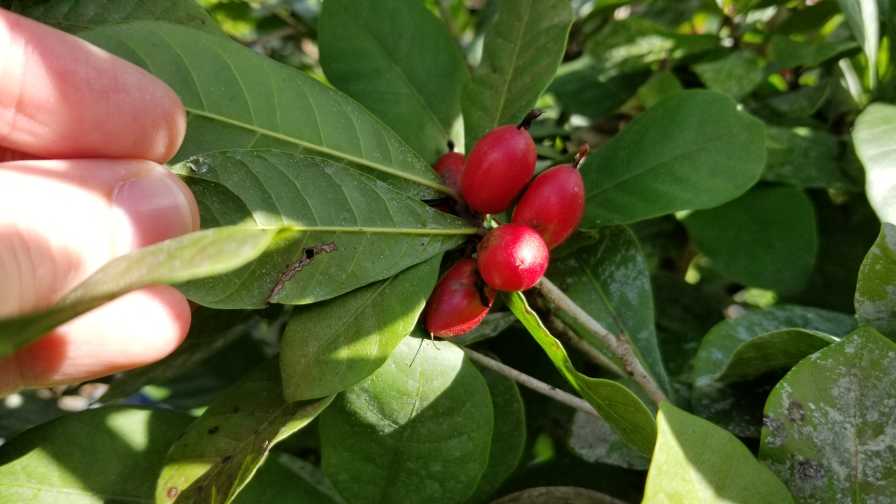
The miracle fruit plant (Synsepalum dulcificum) and its berries have been a flavorful staple in Africa for more than a century. Can this palate-pleasing fruit find a home for production in South Florida? Scientists seem to think so.
Photo courtesy of UF/IFAS
The berry from a miracle fruit plant is quite an enigma to the senses. Foods that are otherwise known to be sour miraculously taste sweet after consuming one of these magic berries. But how do they do that, and what else can they do? University of Florida researchers took an up-close look at the miracle fruit plant and came up with some interesting revelations for growers as well as food and beverage manufacturers seeking an alternative to sugar.
The perennial, which grows natively in Africa and has been consumed for more than a century in that continent for its ability to add sweetness to the blandest and most sour of foods, has a fruit pulp that contains a protein called miraculin. The protein is a taste-modifier, one of only a handful of such naturally occurring molecules in the world that is found in the berries of the plant known colloquially as the miracle fruit (Synsepalum dulcificum).
Alan Chambers of the UF/IFAS Tropical Research and Education Center in Homestead led a study to uncover key information about the miracle fruit plant’s potential. Similarly, Chambers has been studying the viability of another hot alternative crop from far away for South Florida — vanilla.
Critical to the findings in miracle fruit are the varieties identified with the greatest potential for fruit-bearing with the highest potency of the protein and its ability to harvest more efficiently and most often in climates like Africa. The equivalent of those climates are South Florida, Hawaii, and Puerto Rico.
“We now have foundational data on yield and of the concentration of the miraculin protein in the berry,” Chambers said. “The berry, similar in size to a raspberry, is primarily valued for its miraculin content, but what this study did for the first time, is quantify the miraculin in the fruit of select varieties.”
The study was conducted from May 2018 to December 2019 on a private, commercial farm in Homestead. Plants were maintained in 20-gallon pots with 2.5-meter spacing in a shadehouse with supplemental irrigation and fertilized with controlled-release fertilizer.
Chambers and his research team evaluated nine varieties with the most miraculin per pound and per-acre harvested. The sampling was conducted on a plot with 66 trees where researchers analyzed the miraculin potency and statistically looked at the growth of the bush and the berry. During that time, researchers recorded the ability for the varieties to produce six harvest peaks within the year with the largest harvests taking place from May to July.
“We were able to find the winners and the losers,” Chambers said. “If you are just planting seedling stocks, you can potentially have some varieties that have no function. All these things can make a grower more successful by making the farm more efficient. It is a huge advantage in the competitive market.”
Next steps for the research team is to obtain sponsorship to investigate the molecular diversity of the plant and determine the differences between the berries grown in Africa and the U.S.
Stay tuned.
"fruit" - Google News
October 31, 2020 at 08:01PM
https://ift.tt/3el0CMA
Why Miracle Fruit Might Be a Flavorful Fit in Florida - Growing Produce
"fruit" - Google News
https://ift.tt/2pWUrc9
https://ift.tt/3aVawBg
Bagikan Berita Ini















0 Response to "Why Miracle Fruit Might Be a Flavorful Fit in Florida - Growing Produce"
Post a Comment